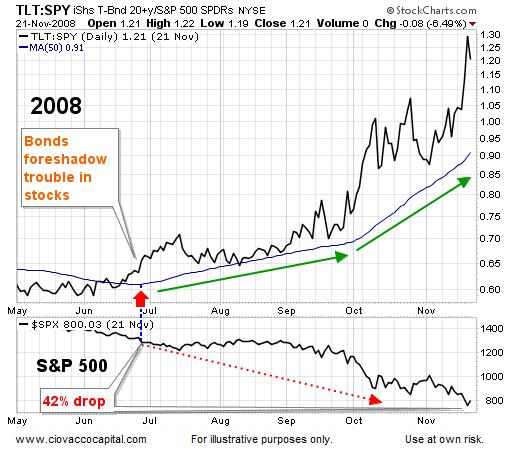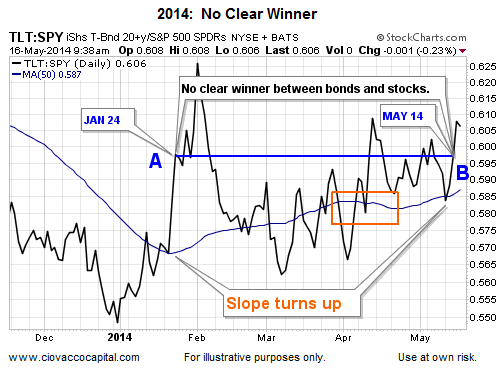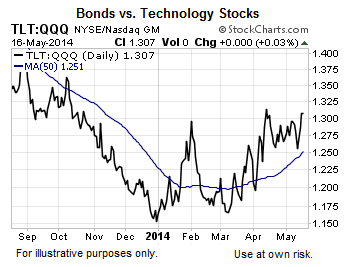Ralph Acampora is known as the Godfather of technical analysis. He also has 13,600 followers on Twitter, which means when the Godfather speaks, investors listen. From MarketWatch:
Ralph Acampora, a known stock bull and technical analysis guru, told CNBC on Thursday before markets closed, that he thinks it could get really bad for stocks and that he has a “sick feeling” about what lies ahead. “If you ask me about the Russell RUT -0.28% and the Nasdaq Composite COMP -0.16% and the S&P MidCap, I think you’re talking about 20, 25%…and I call it a stealth bear market going on,” said Acampora.
Are Investors Confident Or Fearful?
Since the market’s aggregate opinion determines the value of our portfolios, it is logical to monitor the aggregate investor tolerance for risk. Common sense tells us when investors are confident about future economic outcomes, they prefer to own stocks. Conversely, when investors are fearful, they prefer to own defensive-oriented bonds.
Stocks: Bearish Warning From Bonds 2008
The charts below look a little noisy, but the concepts are very easy to understand. The primary portion of the chart below shows the performance of bonds relative to stocks. An observable shift in the aggregate tolerance for risk occurred in late June 2008 when the slope of the 50-day moving average (blue line) turned up (see red arrow in chart). After the observable shift, the S&P 500 dropped an additional 42%. Note there was no need to forecast or anticipate the bearish signal; it was observable before the 42% loss in stocks.

Stocks: Bullish Signal From Bonds 2009
On the same TLT-SPY chart, the slope turned back down in late March 2009, which signaled declining demand for defensive bonds relative to growth-oriented stocks. After the observable shift in investors’ aggregate tolerance for risk, stocks gained an additional 54%.

Present Day Risk Tolerance
What can we learn from the bond/stock ratio today? Several things:
- If we made a friendly bet (no wagering) on January 24 where I picked TLT and you picked SPY, as of May 14 we would have been in a dead heat (no progress between A and B below). That tells us the conviction to own defensive-oriented bonds has been roughly equal to the conviction to own growth-oriented stocks. From a risk tolerance perspective, we can label the current appetite for risk as “undecided”.
- The positive slope of the 50-day currently favors bonds over stocks.
- However, the orange box shows recent “undecided” behavior, meaning the lead from bonds is tenuous.

Yellow Alert For Stocks
We have no problem assigning a “yellow alert” profile to the 2014 stock market. It is not time to run for the equity exits, but it is a good idea to locate the nearest escape hatch. From USA Today:
More stocks hit new lows Tuesday than new highs, despite the S&P 500’s record close. According to Bruce Bittles, chief investment strategist at R.W. Baird, “The fact that breadth is lacking means fewer stocks are participating, which (often occurs) in the later stages of a market advance. While Bittles says the “weight of the evidence is currently on yellow alert,” it would take a “continued breakdown of the broad market” and a sudden rise in investor optimism (which, he says, is unlikely) to “turn the weight of the evidence to red alert.”
Bonds Are Defensive Asset Of Choice
While it is beyond the scope of this article, maximum fear (corrections and bear markets) is a deflationary event in which investors look to lock down safe returns via longer-dated bonds, such as TLT. Therefore we can learn much about the market’s current risk-reward profile by comparing growth investments to the gold standard for maximum fear, TLT. For example, in 2013 small caps IWM were killing bonds. Note the sharp change in risk tolerance that occurred in early 2014 below. In 2014, bonds have been killing small caps.

The story is the same for bonds relative to “I am confident about future economic outcomes” XLY. Stock market bulls prefer a “2013 look” rather than what we have now. The chart below is saying “keep a closer eye on portfolio risk”.

How about one of the 2013 market darlings, tech stocks QQQ? In Led Zeppelin speak, the song remains the same.

Morals from the story: (a) be thankful if you have avoided prolonged exposure to small caps, consumer discretionary, and tech stocks in 2014, (b) bonds have been a better place to be, and (c) the three charts above tell us quite a bit about the net investor expectation for future economic and market outcomes.
What Could Turn The Tide In Bullish Manner?
Intervention from policymakers, and more specifically, central banks is always a good place to start. Despite working the money printers to near exhaustion in recent years, talk of “what lever should we pull next?” is starting to surface again as global growth slows. From The Wall Street Journal:
Five years after the financial crisis ended, soft growth in Europe, a stop-and-start U.S. recovery and waning momentum in China have policy makers groping for what to do next. European Central Bank officials are now moving toward enacting additional low interest-rate policies to prevent the region from sliding into a lengthy period of economic stagnation, while the U.S. Federal Reserve guardedly tries to wind down a bond-buying program meant to revitalize economic growth. Meantime, Chinese authorities are trying to prod banks to lend more to first-time home buyers shut out of their real-estate market. U.S. officials privately say they expect Chinese officials to act to boost their economy and support banks if growth slows severely, though Chinese officials say they will avoid major stimulus if it undermines economic overhauls or deepens credit woes.
Investment Implications – Tentative Market Calls For Mixed Allocation
In June 2008, a clear shift took place calling for a reduction in equity exposure. In 2009, a clear and decisive shift took place in favor of stocks. The terms “clear” and “decisive” do not apply to the present day battle between bonds and stocks. Therefore, until more convincing evidence surfaces, we will continue with a prudent mix of stocks VTI, bonds TLT and cash. When will we shift one way or another? Answer: when the observable evidence changes, which is quite a bit different than saying when we “anticipate” or “forecast” that it will change. While that concept may seem odd at first blush, experienced market professionals know the importance of paying attention rather than trying to predict. Mr. Breakout has over 15,000 followers on Twitter for a reason.
